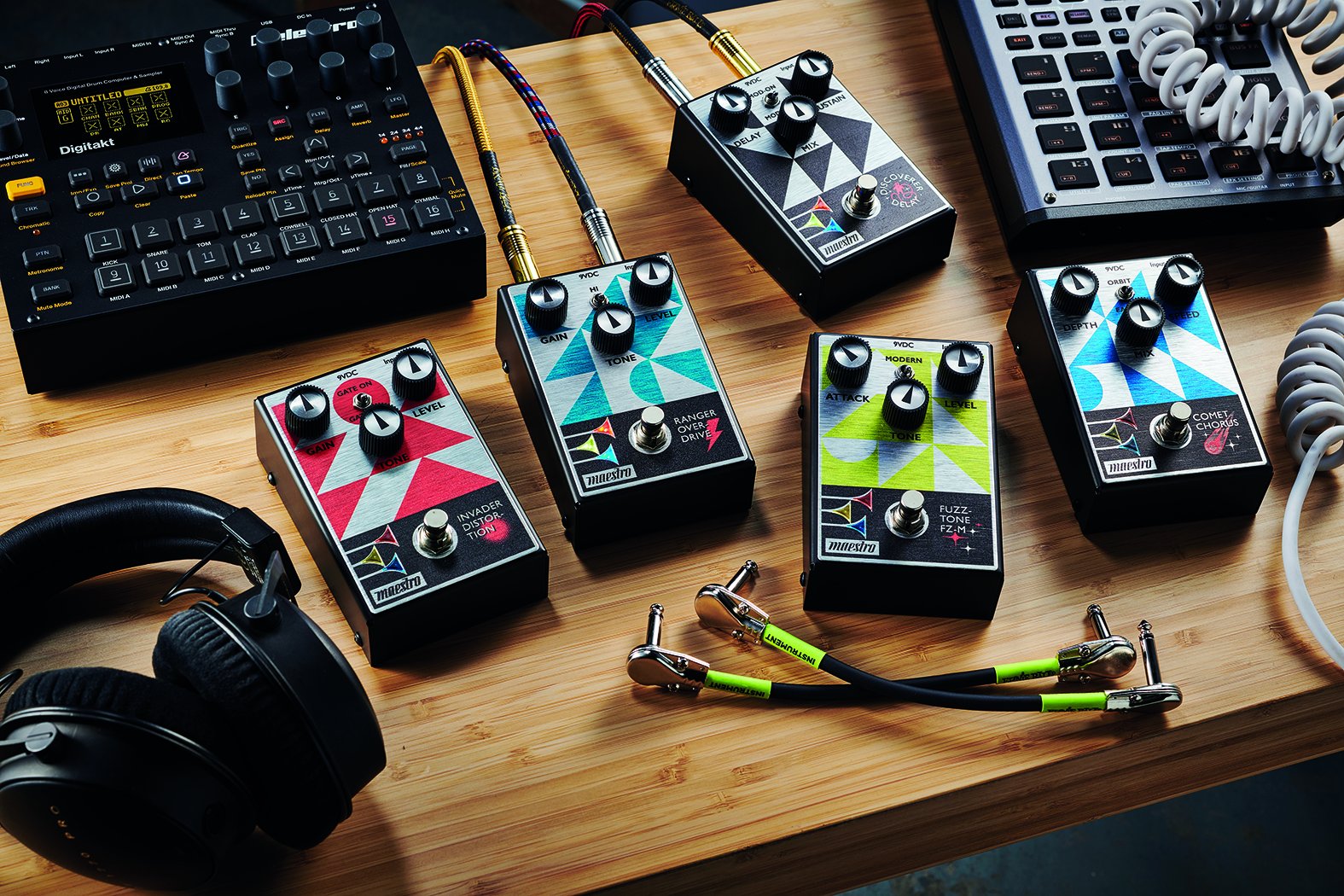MusicRadar Verdict
The Maestro rides again with a mixed bag of effects that bring about a vintage look and sound, dripping in harmonic distortion.
Pros
- +
Ranger Overdrive definitely has ‘range’ from subtle warming up to a hefty crunch.
- +
FZ-M brings the slashing Fuzz Tone sound with fuller tones ready to dial in.
- +
Invader has a raw mid distortion character that is uniquely amp-like.
Cons
- -
Comet Chorus is a little limited in range.
- -
Discoverer Delay repeats break up/down too soon, becoming a chirrup if you’re at high feedback settings.
MusicRadar's got your back
Maestro Original Collection pedals: What is it?
The Maestro name is synonymous with some true classics, like the FZ-1 Fuzz Tone and PS-1 Phase Shifter, as well as a whole roster of oddities like the USS-1 Universal Synthesizer System.
Gibson has kept things on the sober side of history with this new outing of the Maestro label: overdrive, fuzz, distortion, chorus and delay. While the pedal world has increasingly courted the wallets of non-guitarists, especially modular synthesists, the new Maestro line is pointedly guitar-centric, considering 60% of the pedals are variations on distortion. That said, if a pedal works well on guitar, it’ll likely bring some joy to synths, and even more so if it can handle bass well.
The sturdy, slant-topped enclosures carry a unified design with a colour palette that makes them an attractive prospect when lined up, as well as standing out on a pedalboard. This is further aided by the Maestro bugles emblem which carries a trio of coloured LEDs. The screw-hinged bottom plate allows access to the battery clip, as well as trimpots for mode adjustments in the Invader, Comet and Discoverer. All five can be run from a standard 9VDC supply and draw very little current in operation.
Maestro Original Collection pedals: Ranger Overdrive
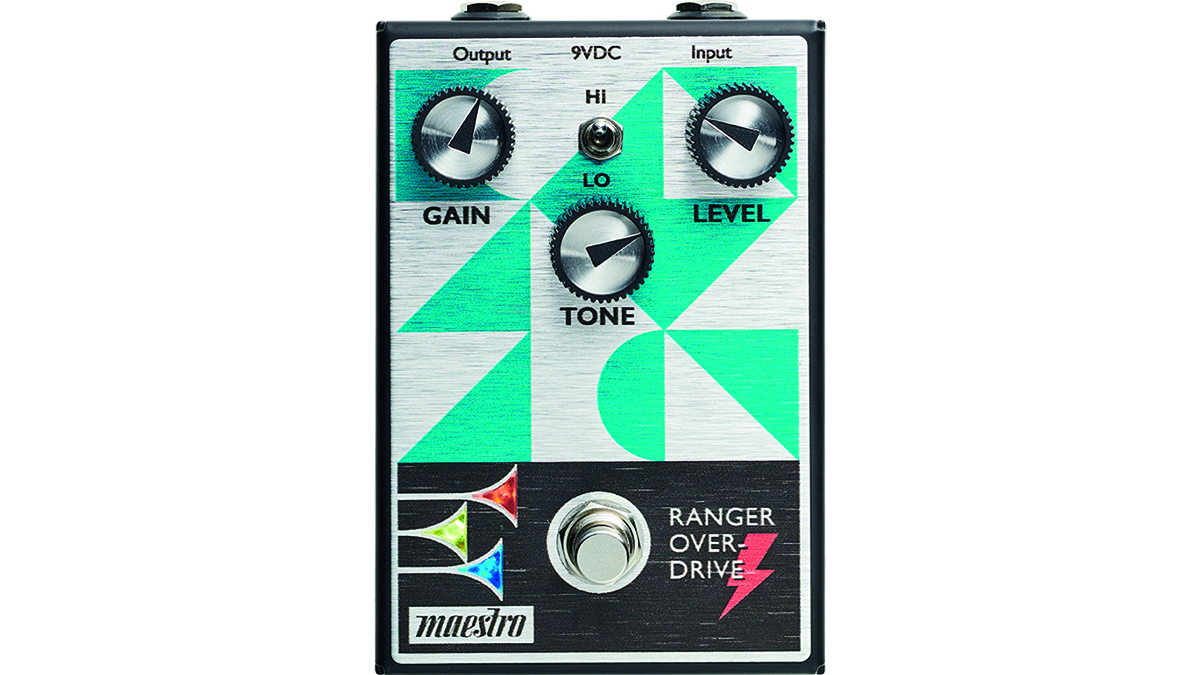
The gentler end of distortion is dealt with by the Ranger Overdrive which features two gain modes (HI and LO) via the toggle switch. The three dials take care of gain, tone and output level, with the latter capable of driving an appreciably hot signal into a valve amp’s front end for extra crunch, or to pummel another pedal’s input stage to (sonic) destruction.
The immediate impression the Ranger makes is in the midrange, particularly the lower end. This pedal is an effective thickener for guitars, basses and synths, adding/enhancing harmonics without overly compressing dynamic range, though there is some inevitable and rather flattering peak clipping happening.
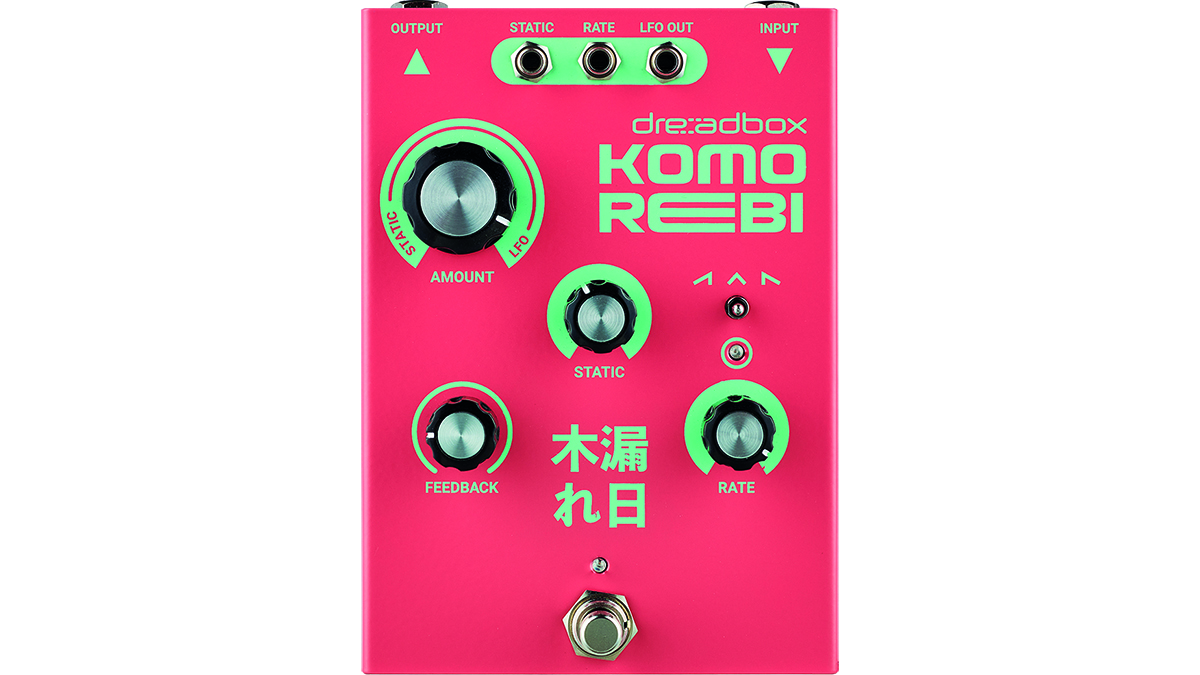
• Dreadbox Komorebi
Chorus and flange get a workout with this modular-friendly package. There’s a huge range of modulation available for guitarists and producers with CV functionality to boot.
• Boss FZ-1W (for FZ-M)
The ’90s FZ-2 and FZ-3 models have garnered such a reputation, as well as some straight up copies, that they got the Waza Craft treatment, resulting in a well priced, high quality standard for fuzz lovers.
• EHX Memory Boy (for Discoverer)
Much of the magic of the Memory Man is captured in this scaled-down version with its great standard of BBD delay alongside some hefty modulation lovers of the wobble.
In LO mode, the Ranger can keep clean-ish at the CCW end of the Gain dial, especially when riding the volume pot on a guitar, while providing thickening and plenty of level boost. It sums in a little of the dry signal in this mode, and this allows the source’s dynamics to remain mostly intact as the Gain is wound up.
Unless the input is extremely treble-heavy, there’s no need to pull the Tone control below 12:00, but there’s plenty of reason to push up from there (it’s a low-pass filter), backing off as the Gain knob goes up. Even fully CW, there’s still an audible roll-off that will trim back the high top of whatever passes through, which is common with a great many overdrives. LO is definitely the mode for gritty funk, whether that’s synth, keys, guitar or bass. On electric pianos it produces a tube amp-style breakup that can be fine tuned and played with dynamics to great effect, though at the heavy end, single-note lines and solos really feel the benefit.
Want all the hottest music and gear news, reviews, deals, features and more, direct to your inbox? Sign up here.
HI is the non-subtle mode and its pronounced mid-focus means the Tone dial will stay regularly near the top, source depending. The distortion really growls without getting nasty, which is tasty on guitars and bass, and brings real grit and girth to synths, from basses to leads.
The Ranger handles bass well, as do all the pedals, and this helps extend the usefulness of this unit. HI mode is 100% overdrive signal so it will readily munch into dynamic range, enhancing sustain and taming harsh transients while adding attitude. The harmonic distortion, probably due to the low-pass filter, fills out the mids without spitting out fizzy highs or overwhelming the low end, even when cranked right up.
Maestro Original Collection pedals: Fuzz Tone FZ-M
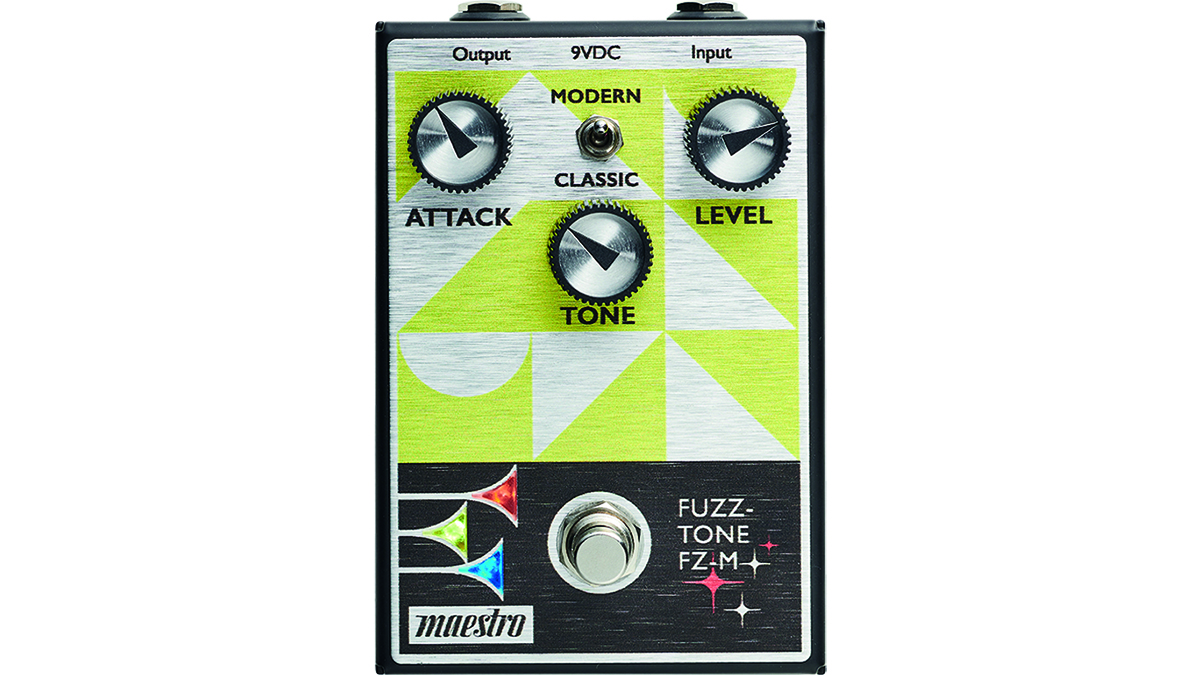
The only throwback to Maestros past, the Fuzz Tone FZ-M pairs a take on the famous FZ-1A (Classic mode) with a more versatile version in the Modern mode. The original Fuzz Tone was an aural slasher, and this is what the Classic mode offers players, though with the Attack (fuzz/clipping amount) turned down, a less ear-splitting fuzz can be corralled, albeit heavily dependent on the source and the Tone control position. In this mode the FZ-M uses a low-pass filter, and whereas the Ranger still rolls off the highs when the filter is fully ‘open’, this one screams at you until right near the end of the CCW line. For guitarists, this unbridled harmonic distortion can be tempered with prodigious use of the instrument’s tone control, and the same goes for synthesists who could pull down any prior low-pass filtering to garner a smoother result.
The Modern mode uses a combined high-pass and low-pass filter depending on which side of 12:00 the Tone knob is sitting, and this, in conjunction with a different fuzz behaviour, produces a distortion that’s more familiar to modern ears. Though the Classic mode is good fuzz to cut through a mix and is eminently playable, the Modern mode is where the FZ-M performs best. As with many fuzzes, it best suits single notes, octaves, and simple diads (root + major 4th or 5th) and will add a distinctive and pleasing old school buzz to instruments. The more low end pushed into the FZ-M, the better it sounds, and simple waveforms (especially sine) can be transformed into something far more exciting before passing into filters, modulations and delays.
Maestro Original Collection pedals: Invader Distortion

In many ways this is the least subtle member of the Maestro Original Collection, serving up a heavy sound that is ‘invasive’ from right across the range of the Gain dial. Like the Range, there is a lot of output level available for crushing whatever sits trembling at the other end of the cable, but there the resemblance ends. Though there is a meaty middle to the Invader sound, it possesses a heavy bottom end that loves to chug. The behaviour is amp-like, growling on the low side of the Gain dial and emitting a deafening roar at the other. There is a grainy roughness that suits hard, punky rhythm guitar playing, and it will rock out the bass thanks to a weighty bottom end. It’s less appealing for the synthesist, though for bass-heavy sounds it will provide an overblown low buzz that may prove useful. Though the Tone knob lacks a little range, the Invader doesn’t have a fizzy top end that needs reining in.
The toggle switch brings a gate into play, the threshold for which can be adjusted via an internal trimpot. It’s a simple gate that’s adequate and will aid chopping playing without spluttering but it’s no match for a dedicated pedal.
Maestro Original Collection pedals: Comet Chorus
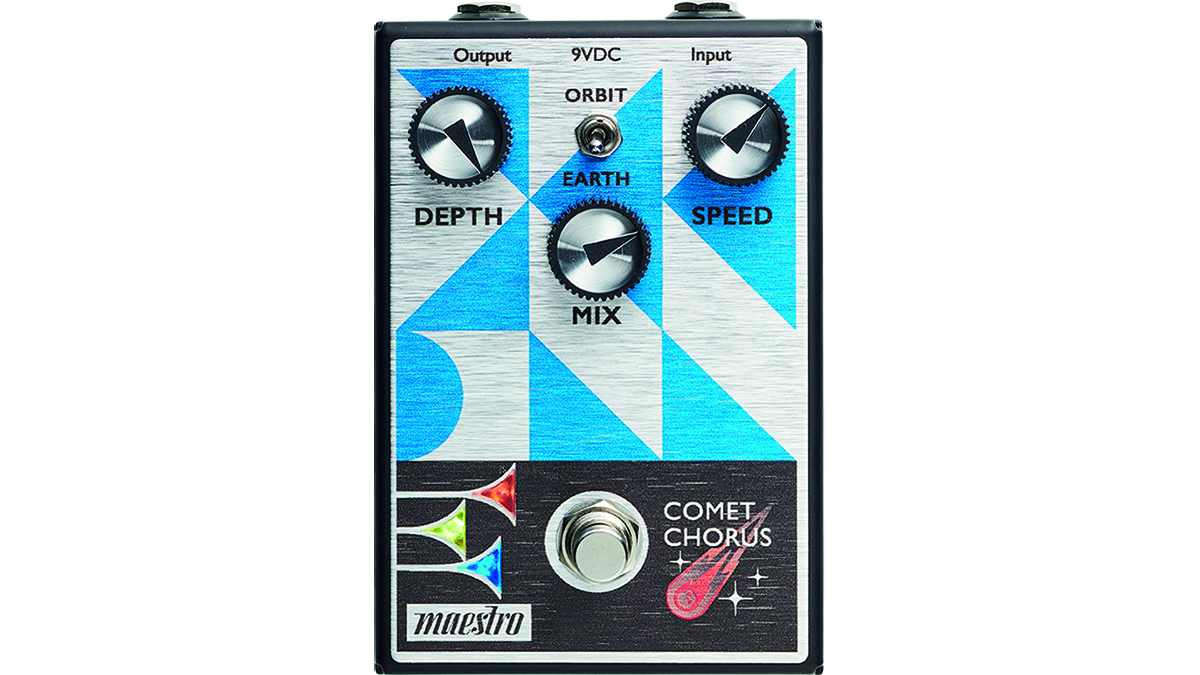
Modern Maestro’s only modulator brings two modes of chorus: Earth and Orbit. Earth is the straight-up chorus and Orbit leans more into the rotary/vibrato sound. An internal trimpot controls how much Orbit deviates from Earth. The effect is more akin to tremolo, though that’s not necessarily a bad thing. The main chorus sound is quite a thick, mid-focussed affair which forgoes some of the wispy qualities some choruses display.
It can be a little too subtle on lower Depth and Mix settings, and the Rate knob sits well within the sensible range, which may put off those looking for more ‘weirdness’ for their modular setups. For guitars, keys and synths the Comet does add a juicy modulation that won’t get in the way, and the Orbit semi-trem sound brings extra movement to the source. What it does, it does well, but it feels like it should do a bit more, be just a little bit wilder.
Maestro Original Collection pedals: Discoverer Delay
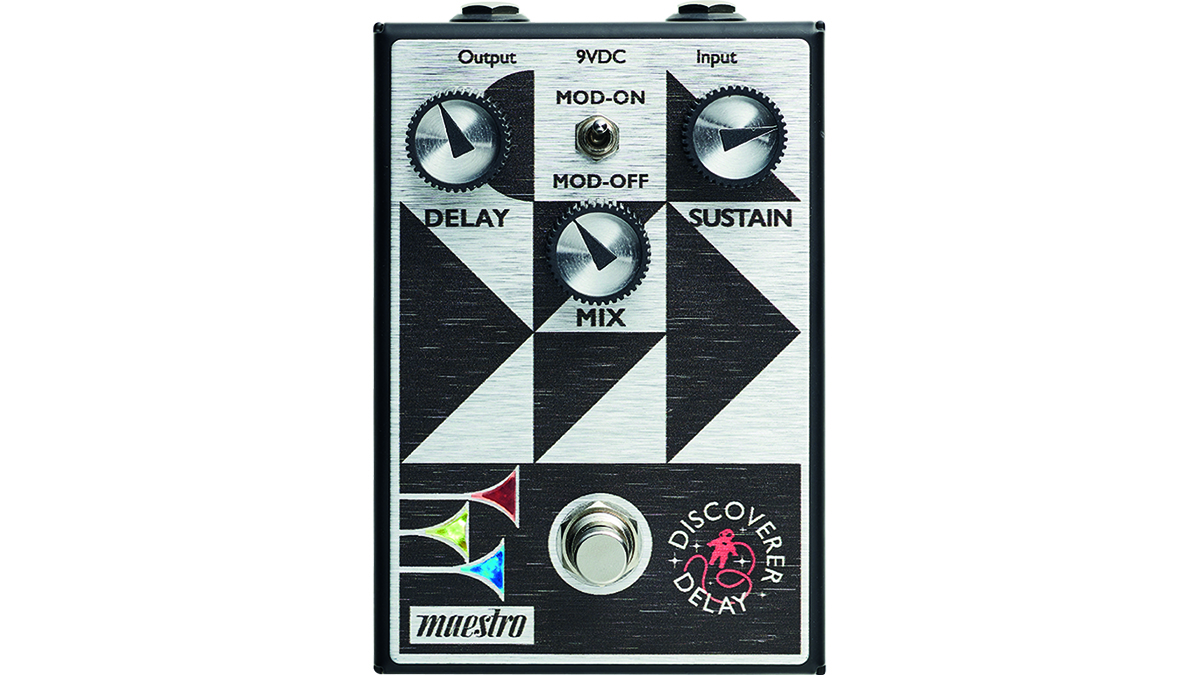
Instantly the Discoverer serves up an identifiably analogue BBD delay sound. At the short end, the delay makes a complementary pseudo-reverb, with modulation Mode bringing an extra dimension that soon shifts into chorus territory as the Delay knob moves up. Two internal trimpots are available to set the modulation depth and rate, the range of which allows everything from a slight swirl to a rapid jelly wobble. The delay time range is well set so the longest doesn’t produce too much BBD noise. The repeats have a well balanced tone so they won’t get in the way even with a high mix ratio, but they don’t lack detail in the first instance either.
The onset of break-up is a little quick, which will appeal to those looking for a dirty or distorted feedback, but the drawback is that as the Feedback knob passes the midway point, the sooner the decays distort themselves into something resembling a chirrup. At extreme settings this almost transient decay sound is fun to spin around in time with the Delay knob, but it lacks the richness of a more subtle feedback breakup that steadily degrades the signal.
Away from the extremes, Discoverer provides a musical analogue delay with a distinctly vintage vibe for creating space and rhythmic interplay that will suit synthesists and reampers as much as guitarists and keyboard players.
Maestro Original Collection pedals: Verdict
The highlights of the collection are in the distortion arena, ie the Ranger Overdrive and Fuzz Tone FZ-M. The vintage funk and grit is a consistent quality throughout, but maybe the coherence of the control set has hemmed them into being too sensible or limited with regard to Comet Chorus and Discoverer Delay.
Consistent quality, but the coherence of the control set has hemmed them in
Maestro is known for many idiosyncratic yet beautiful creations, such as the Bass Brassmaster (absurd origin story, unique/bonkers design, glorious sound), but idiosyncrasy may not be profitable.
Though these are not expensive pedals, they face stiff competition from both the big names and some of the simpler/cheaper offerings from the small producers; just under £150 is a sort of no man’s land between mass production and boutique. Fans of overdrive and fuzz are advised to set foot there.
MusicRadar verdict: The Maestro rides again with a mixed bag of effects that bring about a vintage look and sound, dripping in harmonic distortion.
Maestro Original Collection pedals: The web says
"They look awesome, offer practical functionality, and sound great by just about any measure."
Premier Guitar
Maestro Original Collection pedals: Hands-on demos
Gibson TV
Reverb
Andertons Music Co
Maestro Original Collection pedals: Specifications
- IMPEDANCE I/O: 32kΩ/5kΩ (Fuzz Tone FZ-M), 1MΩ/1kΩ (Ranger), 100kΩ/100Ω (Invader), 470kΩ/1kΩ (Comet), 470kΩ/1kΩ (Discoverer).
- BYPASS: True Bypass.
- CURRENT DRAW: 21mA (FZ-M), 30.4mA (Ranger), 56.7mA (Invader), 55.4mA (Comet), 61.3mA (Discoverer).
- POWER: 9VDC centre negative and 9V battery operation.
- DIMENSIONS: 128 x 88 x 64mm.
- WEIGHT: 556g to 576g (model dependent).
- PRICING: Ranger, FZ-M, Invader, Comet – £139, Discoverer – £149.
- CONTACT: Maestro/Gibson
